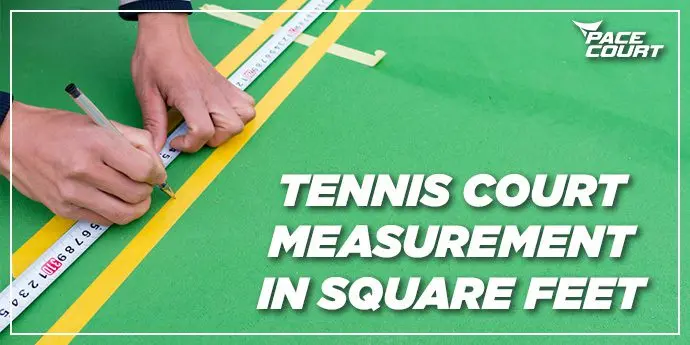Tennis, tracing its origins back to the 12th century, has witnessed tremendous evolution over the years. Not only have the court surfaces evolved but so have their dimensions. The Tennis Court Size in Square Feet, influenced by technological advancements, has standardized to optimize the player's experience. One monumental shift in court construction has been the adoption of synthetic acrylic sports flooring, with leading companies like Pacecourt at the forefront. This article delves into the specific dimensions and design of a standard tennis court, shedding light on the Tennis Court Size in Square Feet, and underscores the myriad benefits brought about by synthetic acrylic sports flooring.
1. Dimensions of a standard tennis court
According to International Tennis Federation (ITF) regulations, a typical tennis court has the following tennis court measurements:
A tennis court's overall dimensions for doubles matches are 78 feet (23.77 meters) in length and 36 feet (10.97 meters) in width. The width is lowered to 27 feet (8.23 meters) for singles bouts.
Service Boxes: The service boxes are 21 feet (6.4 meters) deep and are situated on either side of the court.
Net: The net, which divides the court in half, is 3 feet (0.914 meters) tall in the centre and 3.5 feet (1.07 meters) high at the posts.
Taking into account the aforementioned measurements, a typical tennis court requires 2,808 square feet for singles and 3,504 square feet for doubles.

2. Further Area Considerations
The dimensions of the playing field are conventional, however, more room advised surrounding the court to allow for movement by players, and spectators, and to ensure safety.
Run-off Space:
For competitive or professional matches, it is generally recommended to leave a minimum of 12 feet (3.66 meters) behind the baseline and 6 feet (1.83 meters) on the sides.
The entire area of a typical tennis court (including the surrounding region) would be about 6,480 square feet after accounting for the extra run-off space.
3. The Future of Tennis Courts: Synthetic Acrylic Sports Flooring
Tennis courts are now built very differently because of Pacecourt's invention of synthetic acrylic sports flooring material.
Advantages of synthetic acrylic flooring
Durability:
Sports flooring made of acrylic is renowned for its durability. Acrylic courts offer longevity in contrast to traditional grass or clay courts, which can deteriorate and need regular care.
Consistent Bounce:
A fair game environment is created by the uniform surface, which guarantees that the ball bounces consistently.
Environmental Resistance:
Acrylic flooring is a popular option for both indoor and outdoor courts since it is resistant to a variety of environmental factors, including UV rays and wetness.
Low Maintenance:
Acrylic courts are generally low maintenance, requiring only occasional cleaning, in contrast to clay courts which require frequent watering and rolling, or grass courts that require mowing.
Customizability:
These courts can made in a variety of colours, allowing establishments or individuals to design their courts to suit their tastes.
4. Pacecourt's Effect on the Industry
As the first business to produce synthetic acrylic sports flooring material, Pacecourt has established standards for the sector. Their inventions have changed not just the way tennis courts are built but also how the sport is played. Pacecourt has improved tennis play for both beginners and professionals by offering a surface that is consistent, robust, and player-friendly.
Slide, Bounce, Win! All on Our Acrylic Sports Surface.
| Tennis Court Flooring | Basketball Court Flooring | Volleyball Court Flooring |
| Badminton Court Flooring | Skating Rink | Walking track |
5. Conclusion
The tennis court, while preserving its regular proportions, has seen advancements in the materials used for its surface. The Tennis Court Size in Square Feet remains standard, but there's a notable shift towards innovative flooring options. Synthetic acrylic sports flooring, championed by companies like Pacecourt, offers several advantages over traditional surfaces. As tennis continues to be a beloved sport globally, ensuring the game's integrity and enhancing the player experience through optimal court surfaces remains paramount.




Merely wanna state that this is very beneficial, Thanks for taking your time to write this.
It’s hard to find educated people about this topic, however,you sound like you know what you’re talking about!Thanks
Major thankies for the article post.Really looking forward to read more. Much obliged.
Fantastic blog.Much thanks again. Cool.
Very good article.Really looking forward to read more.
Thank you for your blog post.Really looking forward to read more.
I really enjoy the blog post.Much thanks again. Fantastic.
I truly appreciate this article post. Really Great.
Im thankful for the blog article.Thanks Again. Will read on…
Thanks so much for the blog post.Really looking forward to read more. Awesome.
Really informative article post.Much thanks again. Great.
I think this is a real great blog post.Really thank you! Really Cool.
I appreciate you sharing this blog article.Much thanks again. Really Great.
I truly appreciate this article post.Really thank you! Fantastic.
Thanks for sharing, this is a fantastic blog article.Much thanks again. Fantastic.
Appreciate you sharing, great article post.Thanks Again. Really Cool.